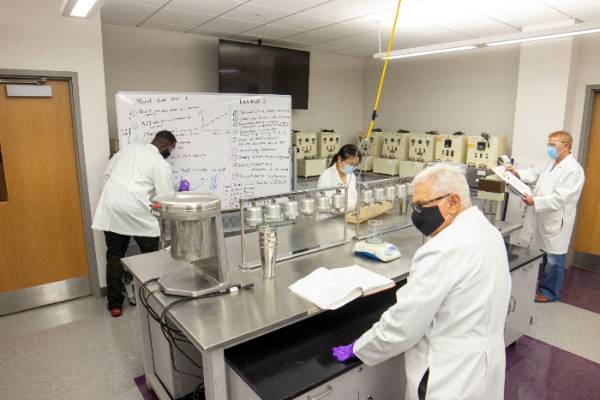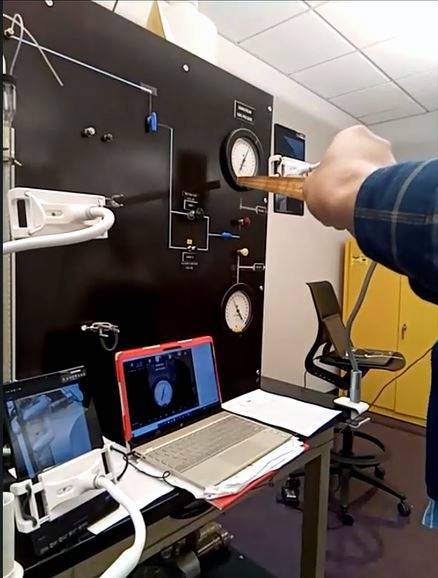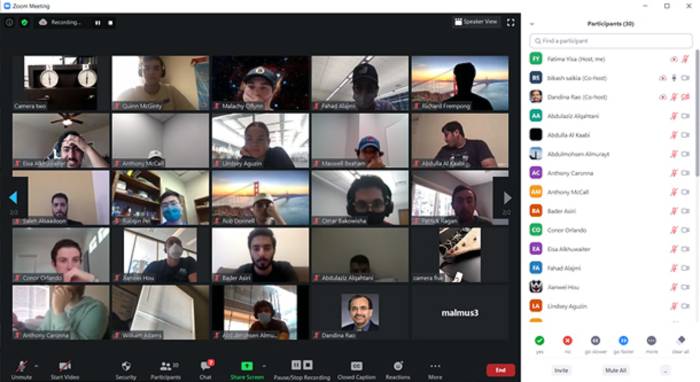Petroleum Engineering Adapts Labs to Hybrid Teaching Environment
December 9, 2020
 BATON ROUGE, LA – Over the course of the year, as a result of the coronavirus pandemic,
colleges and universities have had to adjust their educational delivery model from
in-person instruction to completely virtual or to a hybrid model involving both.
BATON ROUGE, LA – Over the course of the year, as a result of the coronavirus pandemic,
colleges and universities have had to adjust their educational delivery model from
in-person instruction to completely virtual or to a hybrid model involving both.
The LSU College of Engineering has not been immune to these challenges and has had to find new ways to continue educating its students, particularly when it comes to the various hands-on, in-person labs that are a part of the curriculum.
The Craft & Hawkins Department of Petroleum Engineering, for instance, adapted its teaching labs quickly in spring 2020 and has continued to do so this fall. The following are a few examples of the way the department has managed its labs in a time of social distancing during a pandemic.
Rock and Fluid Properties Lab – Professor Seung Kam
Before and during the fall semester, Kam’s teaching assistants Yanfang Wang and Hazem Fleifel and Coordinator Fenelon Nunes made videos and captured photos of lab materials and set ups. On Wednesdays, students received an invitation to attend Zoom lectures with TAs. A lecture would be delivered, followed by interactive quiz questions that could be answered through email in real-time.
On Thursdays and Fridays, students watched the pre-recorded videos and Moodle materials to work on their lab reports based on the previous year’s data. They then had the weekend to submit their reports. On Mondays and Tuesdays, TAs graded the quizzes and reports, emailed individual students regarding their scores and comments on their reports, and the students then asked questions about their graded materials. On the next Wednesdays, the process repeated.
“It has been a very busy semester for me, the TAs and Mr. Nunes,” Kam said. “After digesting all 12 experiments offered in this course, students are required to design their own experiments, analyze data, summarize results, and provide conclusions during the last couple of weeks of this semester from either ‘absolute permeability’ or ‘resistivity’ experiments. Specifically, there are two semester-end assignments related to that—preparing technical presentation slides, like that of a formal conference presentation, and making a movie summarizing their own experimental study in their own unique ways.
“The amount of work this semester is equivalent to, or slightly more than, that in the previous years. The last two assignments hopefully provide hands-on experience from their own residence; [think of them] as extra assignments for this semester.”
Kam added that he missed the “hands-on components” that normally come with the lab but felt that the efforts were successful. While not ideal for all involved, the students seemed to agree with him.
“I had in-class surveys twice and writing components as part of their lab report twice to seek student feedback during the semester,” Kam said. “The outcome showed a wide-range of spectrum. Some students seemed quite satisfied, feeling secure and safe and appreciating the quality of the course. Others expressed their eagerness towards actual lab experience without actually being bothered by this pandemic.”
 Reservoir Mechanics Lab – Professor Dandina Rao
Reservoir Mechanics Lab – Professor Dandina Rao
For each of the 10 experiments conducted during the fall semester, Rao pre-recorded a video lecture that students were required to watch the day before that experiment would be carried out in the lab. On the day of the lab, students began with a short quiz on the lecture to ensure they understood the purpose of the experiment, the apparatus they would be using and its operational details, the safety measures to be observed, the data to collect, and how to write a report on the experiment and their observations.
Inside the lab, Rao’s research associate and postdoctoral researcher, Bikash Saikia, physically ran each experiment with the help of TAs Fatima Yisa and Muzher Al-Musabeh, both PhD students of Rao. While the students observed over Zoom, Rao asked and answered questions and had lively discussions about the experiments related to real-world petroleum reservoir situations.
Students were assigned tasks on a rotating basis to announce the observed readings while all students recorded the data to use for their reports. This ensured that every student, around 20 in each lab session, was able to participate in conducting the experiment.
“There is nothing like doing things hands-on in a lab and learning while doing it,” Rao said. “Since that was not possible due to the current pandemic, the next best thing was giving the students as realistic a feel of the experiment as possible and to let them engage. Considering the circumstances, we believe students are doing well in terms of learning the fundamentals of the experiments. The lab reports they are submitting every week indicate that the learning is happening and they are able to understand the subject material.”
During the semester, LSU has heard from concerned parents that virtual or hybrid instruction results in less of an educational experience. Rao said it was a valid concern but that he had seen no evidence to warrant it.
“This virtual approach is certainly a newer way and requires us all to get used to it, but in many ways, it has its upside as well,” he said. “For example, student-teacher presence gets enhanced through the speaker-view design of Zoom and hence, everyone is heard equally well. Students can also ask questions through the chat and even privately if they wish to, and that takes out the fear-factor in asking questions. They can also watch the recording of their class again and again and can refresh what they learned during the lab, unlike the one-time experience in the physical lab/classroom.
“Even though students miss out some on physical interactions, in terms of learning, they shouldn’t miss out much. In fact, if they take interest, they can actually learn more from closer and numerous interactions in every Zoom session. We can see that some students are taking advantage of this.”
 Drilling Fluids Lab – Professor Andrzej (Andrew) Wojtanowicz
Drilling Fluids Lab – Professor Andrzej (Andrew) Wojtanowicz
The Drilling Fluids Lab normally comprises two components—a hands-on testing component, or wet lab, and the process design component, or technical report. This fall semester, 59 students were enrolled across three sections of the lab. Over the 12-week period, each student section conducted 10 weekly experiments and took two in-person exams, as well as one online. Instead of eliminating in-person lab attendance altogether, Wojtanowicz surveyed the class to get its feedback on what it would prefer. Where they landed was a hybrid format of virtual and in-person work.
The virtual component involved a one-hour, online Zoom lecture on Mondays for the entire class in which a new experiment was discussed, followed by a 10-minute online quiz. During the week, students could perform “virtual experiments” in their free time by watching a video of the pre-recorded experiment conducted by a TA and uploaded to Moodle. They could also discuss the subject with their weekly team partners and seek clarification from the instructor or TA. A unique set of experimental results was subsequently given to each two-student team, and based upon the results, the team would write and submit a technical report suggesting a solution to a well-drilling problem.
In addition to the two exams, the in-person component was designed and offered on a voluntary basis to students interested in practicing the actual wet lab-work. Each student was given an opportunity to register for two “lab drills” during the semester. Therefore, only two, instead of 20, students were concurrently present in the lab to learn and practice the use of the instruments and perform basic tests on samples of drilling fluid prepared by the lab technician under guidance of a teaching assistant.
“There is no substitution for hands-on experience in the wet lab, in my opinion, so the students could not fully learn the practical aspects of drilling mud technology that involves making decisions based on laboratory pilot testing. However, the ‘lab drills’ helped a lot,” Wojtanowicz said.
Like us on Facebook (@lsuengineering) or follow us on Twitter and Instagram (@lsuengineering).
###
Contact: Joshua Duplechain
Director of Communications